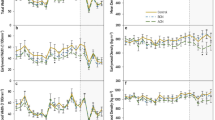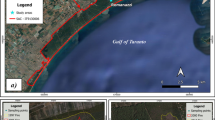Abstract
Red pine (Pinus resinosa Ait.) is rare (< 15 000 mature trees) in Newfoundland and is known from only 22 locations in the central region. Red pine occupies 3 major site types in Newfoundland: 1) red pine on medium-textured sands (RP1), 2) red pine on coarse-textured glaciofluvial deposits (RP2), and 3) red pine on Folisols over bedrock (RP3). The succession of red pine site types after cutting is from red pine to Kalmia-black spruce (Picea mariana (Mill.) B.S.P.) for RP1, and to Cladonia-Kalmia-black spruce for types RP2 and RP3. Succession after fire is usually to the pre-fire type, but this depends on the severity of the fire.
Although occupying a relatively poor site, red pine at 60–70 years reaches heights in excess of 18 m, dbh in excess of 40 cm, and individual tree volumes greater than 1 m3 were recorded in 75 stemanalyzed fire-killed trees. Black spruce on that same site produces less than one-third that volume in 60 years. Merchantable volume of 140–280 m3 ha-1 were recorded i.e., Canada Land Inventory (CLI) forest capability class 5 and class 4 ratings. This raises the CLI rating two capability classes if red pine were occupying these poor quality sites over black spruce. In terms of nutrition, even the best growing red pine are nitrogen (N) deficient as shown by foliar analysis. All natural stands have foliar N concentrations below 1.3% which is the critically low level shown in the literature. Immediately after fire, foliar concentrations reach this level but are usually about 1% or less. Most other nutrients are low but are within the generally reported adequate levels in testing for P, K, Ca and Mg.
Fire influences soil nutrient availability as pH increases in the RP1 type. Burning temperature also affects soil pH and the understory vegetation. The RP2 type loses more N in hotter burns on this site type and more N is tied up in these ortstein hardpan soils. The pattern of regeneration following wildfire is related to slope, density, age and species mixture of the stand as well as the thickness and composition of the duff layer.
Similar content being viewed by others
References
AlbanD.H.: 1974, ‘Red pine site index in Minnesota as related to soil and foliar nutrients’, Forest Sci. 20, 261–269.
AlbanB.H., PrettymanD.H. and BrandG.J.: 1987, ‘Growth patterns of red pine on fine-textured soils’, Report No. NC-280, US Dep. Agric., For. Serv., North Central Experiment Station, St. Paul, Minnesota, 8 pp.
BarrettS.W. and ArnoS.F.: 1988, ‘Increment-borer methods for determining fire history in coniferous forests’, Gen. Tech. Report No. INT-244, US Dep. Agric., For. Serv., Intermountain Research Station, Ogden, Utah, 15 pp.
BeckwithA.F., RoebbelenP. and SmithV.G.: 1983, ‘Red pine plantation growth and yield tables’, Field Reg. Report No. 108, Ont. Min. Nat. Resour., Ontario Tree Improvement and Forest Biomass Institute, Maple, Ontario, 70 pp.
BergeronY. and GagnonD.: 1987, ‘Age structure of red pine (Pinus resinosa Ait.) at its northern limit in Quebec’, Can. J. For. Res. 17, 129–137.
BrassardG.R.: 1983, ‘Checklist of the mosses of the Island of Newfoundland, Canada’, Bryologist 86, 54–63.
ButsonR.G., KnowlesP. and FarmerR.E.: 1987, ‘Age and size structure of marginal disjunct populations of Pinus resinosa’, J. Ecology 75, 685–692.
Canadian Soil Survey Committee: 1978, ‘The Canadian system of soil classification’, Publ. No. 1646, Agric. Can., Research Branch, Ottawa, Ontario, 164 pp.
ComerfordN.B.: 1981, ‘Distributional gradients and variability of macroelement concentrations in the crowns of plantation grown Pinus resinosa (Ait.)’, Plant and Soil 63, 345–353.
DammanA.W.H.: 1964, ‘Some forest types of central Newfoundland and their relation to environmental factors’, Contrib. No. 596, Can. Dep. Forestry, Forest Research Branch, Ottawa, Ontario, For. Sci. Monogr. 8, 62 pp.
deNauvoisM. and BuongiornoJ.: 1986, ‘Economics of red pine plantation management in Wisconsin’, North J. Appl. For. 3, 118–123.
FayleD.C.F.: 1975, ‘Extension and longitudinal growths during the development of red pine root systems’, Can. J. For. Res. 5, 109–121.
FernaldM.L.: 1950, Gray's Manual of Botany (8th edition), American Book Company, New York, 1632 pp.
HaleM.E. and CulbersonW.L.: 1966, ‘A third checklist of the lichens of the continental United States and Canada’, Bryologist 69, 141–182.
HonerT.G., KerM.F. and AlemdagJ.S.: 1983, ‘Metric timber tables for the commercial tree species of central and eastern Canada’, Infor. Report No. M-X- 140, Can. For. Serv., Maritime For. Res. Centre, Fredericton, New Brunswick, 130 pp.
HortonK.W. and BedellG.H.D.: 1960, ‘White and red pine: ecology, silviculture and management’, Res. Bull. No. 123, Can. Dep. North. Affairs and Nat. Resour., For. Branch, Ottawa, Ontario, 185 pp.
HosieR.C.: 1979, Native Trees of Canada (8th edition), Fitzhenry & Whiteside Ltd., Don Mills, Ontario, 380 pp.
LuxmoreR.J., GizzardT. and StrandR.H.: 1981, ‘Nutrient translocation in the outer canopy and understory of an eastern deciduous forest’, Forest Sci. 27, 505–518.
MadgwickH.A.I.: 1964a, ‘The chemical composition of foliage as an index of nutritional status in red pine (Pinus resinosa Ait.)’, Plant and Soil 21, 70–80.
MadgwickH.A.I.: 1964b, ‘Variations in the chemical composition of red pine (Pinus resinosa Ait.) leaves: a comparison of well grown and poorly grown trees’, J. For. 37, 87–94.
MallikA.U.: 1987, ‘Allelopathic potential of Kalmia angustifolia to black spruce (Picea marina)’, For. Ecol. Manage. 20, 43–51.
MallikA.U. and RobertsB.A.: 1994, ‘Natural regeneration of Pinus resinosa on burned and unburned sites in Newfoundland’, J. Veg. Sci. 5, 179–186.
McCormackR.J.: 1970, ‘Land capability for forestry, Canada Land Inventory’, Report No. 4., Dep. Regional Economic Expansion, Ottawa, Ontario, 72 pp.
MorrisonI.K.: 1974, ‘Mineral nutrition of conifers with special reference to nutrient status interpretations: A review of literature’, Publ. No. 1343, Can. For. Serv., Ottawa, Ontario, 74 pp.
MosselerA., RobertsB.A. and TriccoP.: 1992, ‘The effect of fir coneworm, Dioryctria abientivorella (Grote) (Lepidoptera: Pyralidae) on seed production in small, isolated populations of red pine’, For. Ecol. Manage. 53, 15–27.
Mueller-DomboisD. and EllenbergE.: 1974, Aims and Methods of Vegetation Ecology, John Wiley and Sons, New York, 547 pp.
RobertsB.A.: 1980, ‘Some chemical and physical properties of serpentine soils from western Newfoundland’, Can. J. Soil. Sci. 60, 231–240.
RobertsB.A.: 1983, ‘Soils’, In: G.R.South (ed.), Biogeography and Ecology of the Island of Newfoundland, Monographiae Biologicae 48, W. Junk Publ. Co., The Hague, Netherlands, pp. 107–161.
RobertsB.A.: 1985, ‘Distribution and extent of Pinus resinosa Ait. in Newfoundland’, Rhodora 87, 341–356.
RobertsB.A.: 1989, ‘Reproduction and regeneration of natural red pine (Pinus resinosa Ait.) in Newfoundland’, Infor. Rep. No. N-X-273, For. Canada, Newfoundland Forestry Centre, St. John's, Newfoundland.
Roberts, B.A. and Bajzak, D.: 1984, A forest site classification for the boreal forest of central Newfoundland, Canada (B.28a) using a biophysical soils approach’, Paper presented at the joint meeting of the Working Parties No. 1.02-06 and No. 1.02-10 of IUFRO on Qualitative and Quantitative Assessment of Sites with Special Reference to Soil, Birmensdorf, Switzerland, 18 pp.
RobertsB.A. and MallikA.U.: 1994, ‘Responses of Pinus resinosa in Newfoundland to wildfire’, J. Veg. Sci. 5, 187–196.
Timmer, V.R. and Morrow, L.D.: 1984, ‘Predicting fertilizer growth response and nutrient status of jack pine by foliar diagnosis’, In: E.L. Stone (ed.), Forest Soils and Treatment Impacts, 6th North American Forest Soils Conference, Univ. Tennessee, Knoxville, Tennessee, pp. 335–351.
WellsR.E. and RobertsB.A.: 1973, ‘Bio-physical survey of the Badger-Diversion Lake area, Newfoundland, Operational Project of the National Committee on Forest Lands’, Infor. Report No. N-X-101, Can. For. Serv., Newfoundland For. Research Centre, St. John's, Newfoundland, 54 pp.
ZakrevskyJ.G.: 1984, ‘Methods manual, chemical and physical analysis laboratory’, Unpublished Report, Can. For. Serv., Newfoundland Forest Research Centre, St. John's, Newfoundland.
Author information
Authors and Affiliations
Rights and permissions
About this article
Cite this article
Roberts, B., Bajzak, D. Site characteristics, growth and nutrition of natural red pine stands in newfoundland. Environ Monit Assess 39, 509–530 (1996). https://doi.org/10.1007/BF00396165
Issue Date:
DOI: https://doi.org/10.1007/BF00396165




